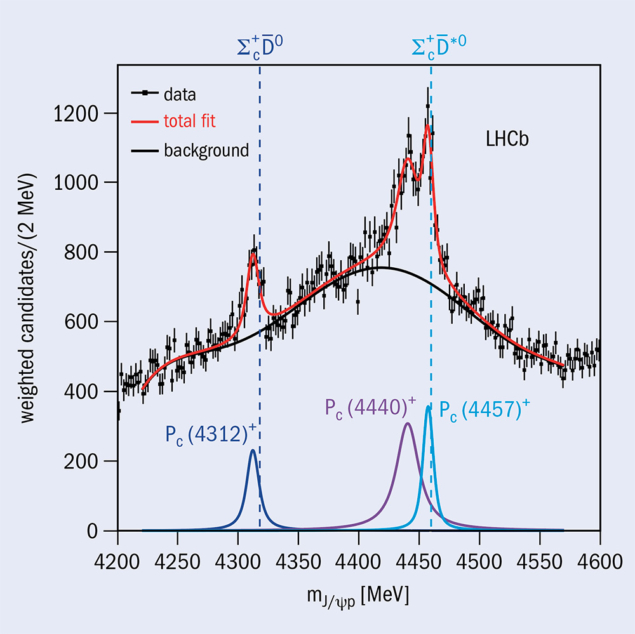
The LHCb collaboration has discovered a new pentaquark particle, dubbed the Pc(4312)+, decaying to a J/ψ and a proton, with a statistical significance of 7.3 standard deviations. The LHCb data, first presented at Rencontres de Moriond in March, also confirm that the Pc(4450)+ structure previously reported by the collaboration in 2015 has now been resolved into two narrow, overlapping peaks, the Pc(4440)+ and Pc(4457)+, with a statistical significance of 5.4 standard deviations compared to the single-peak hypothesis (figure 1). Together, the results offer rich studies of the strong internal dynamics of exotic hadrons.
In the famous 1964 papers that set out the quark model, Murray Gell-Mann and George Zweig mentioned the possibility of adding a quark–antiquark pair to the minimal meson and baryon states qq̅ and qqq, thereby proposing the new configurations qqq̅q̅ and qqqqq̅. Nearly four decades later, the Belle collaboration discovered the surprisingly narrow X(3872) state with a mass very close to the D0D̅*0 threshold, hinting at a tetraquark structure (cc̅uu̅). A decade after that, Belle discovered narrow Zb0,± states just above the BB̅* and B*B̅* thresholds; this was followed by observations of Zc0,± states just above the equivalent charm thresholds by BES-III and Belle. The existence of charged Zb± and Zc± partners makes the exotic nature of these states clear: they cannot be described as charmonium (cc̅) or bottomonium (bb̅) mesons, which are always neutral, but must instead be a combination such as cc̅ud̅. There is also evidence for broad Zc± states from Belle and LHCb, such as the Zc(4430)±.
A major turning point in exotic baryon spectroscopy was achieved by LHCb in July 2015 when, based on an analysis of Run 1 data, the collaboration reported significant pentaquark structures in the J/ψ−p mass distribution in Λb0 → J/ψpK− decays. A narrow Pc(4450)+ and a broad Pc(4380)+ were reported, both with minimal quark content of cc̅uud (CERN Courier September 2015 p5).
The new results use the data collected at LHCb in Run 1 and Run 2, providing a Λb0 sample nine times larger than that used in the 2015 paper. The new data reproduce the parameters of the Pc(4450)+ and Pc(4380)+ states when analysed the same way as before. However, the much larger dataset makes a more fine-grained analysis possible, revealing additional peaking structures in the J/ψ-p invariant mass spectrum that were not visible before. A new narrow peak, with a width comparable to the mass resolution, is observed near 4312 MeV, right below the Σ+cD̅0 threshold. The structure seen before at 4450 MeV has been resolved into two narrower peaks, at 4440 and 4457 MeV. The latter is right at the Σ+cD̅*0 threshold.
These Pc states join a growing family of narrow exotic hadrons with masses near hadron–hadron thresholds. This is expected in certain models of loosely bound “molecular” states whose structure resembles the way a proton and neutron bind to form a deuteron. Other models, such as of tightly bound pentaquarks, could also explain the Pc resonances. A more complete understanding will require further experimental and theoretical investigation.
Further reading
LHCb Collaboration 2019 arXiv 1904.03947 (submitted to Phys. Rev. Lett.).





